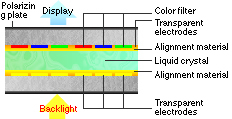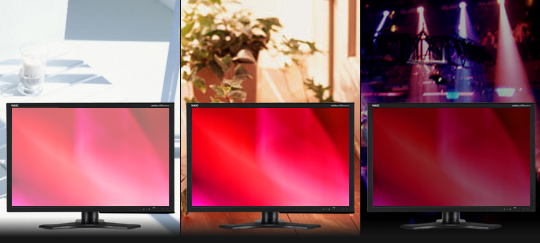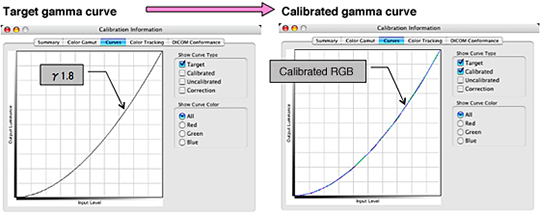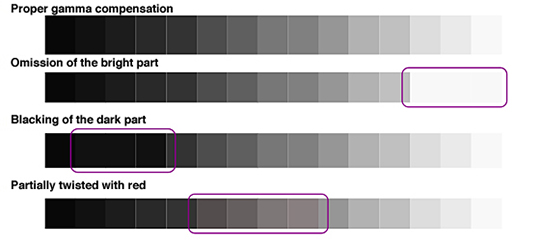Please note that JavaScript and style sheet are used in this website,
Due to unadaptability of the style sheet with the browser used in your computer, pages may not look as original.
Even in such a case, however, the contents can be used safely.
Luminance technology
What is the Luminous Technology?
The brightness is measured with the intensity of three principle colors namely R (red), G (green), and B (blue) of the light emitted from the monitor.
Luminous structure of the LCD monitor

The luminous device is the backlight arrayed on the backside of the LCD panel. The light emitted from the backlight of the LCD panel will reach the front surface of the panel or stop in the LCD from the effect of the LCD that transmits or stops the light depending on the availability of the added voltage. If the light reaches the front surface of the panel, it will be lighted, otherwise will not be lighted. The light reaches the color filters (RGB) that are adhered to the respective sub pixels on the front surface of the panel, and then colors of red, green, and blue are emitted to reproduce various kinds of colors depending on the mixing ratio of the respective principle colors.
Backlight
The high grade series employs direct backlight where the backlights are arrayed uniformly on the backside of the screen. If the lamps are turned on as they are, lines from the respective lamps may appear. Thus, the monitor has a design using a special light diffusion sheet to light the lamp uniformly. The brightness emitted from the monitor is strictly measured with the dedicated sensor built into the monitor. The models in the high-grade series apply the H-IPS (Horizontal In-Plane-Switching) panel using state-of-the-art technologies. In comparison to the ordinary IPS panel, the glass opening rate has been improved drastically, and high brightness and high color reproduction areas have been achieved.

Appropriate brightness
Strict brightness is required for a monitor for professional use. For instance, for a photographer, the required brightness is 80 to 100 cd/m² at the gamma value of 1.6 to 1.8 and the color temperature of 4,000 to 5,000K. In the printing industry, the brightness when sRGB is used is 80 cd/m², while it is 80 to 160 cd/m² when Adobe RGB is used. The appropriate standard values of the gamma value are 2.2 (Windows) or 1.8 (Macintosh), and the same of the color temperature is 5,000K. The appropriate standard values for operation are previously set.

Gamma
The gamma is an index indicating the level of brightness applied to certain input data such as images coming into the monitor. It is also referred as the gamma property, and the respective values are referred as the gamma value. The relation between the input and the output is shown in the graph below. If images are displayed in accordance with the curve shown in the graph, smooth, natural gradations can be obtained. However, the gamma property of LCD panel does not necessarily indicate the theoretical proportional relationship due to various practical problems. Therefore, the monitor for professional use, which requires a strict gamma property, is equipped with the gamma compensation function.

NEC’s Luminous Technology
The models in the high grade series are equipped with the gamma adjustment function to compensate color reproduction for suppressing the omitted gradation and to achieve smooth color expression. This gamma adjustment function supplements differences in gamma properties of the respective monitors and then adjusts the compensation within the monitor. One of the unique points is that the 12-bit lookup table is applied to the respective colors of R (red), G (green), and B (blue). Although omitted gradation and blacking at low brightness could not be eliminated with the ordinary 10-bit gamma compensation function, it is possible to eliminate them with this arrangement. This smoothness of gradation is achieving the boundary of visibility with the human eye. The monitor is capable of level of accuracy sufficiently corresponding to professional users who often use the monitor at low brightness.

